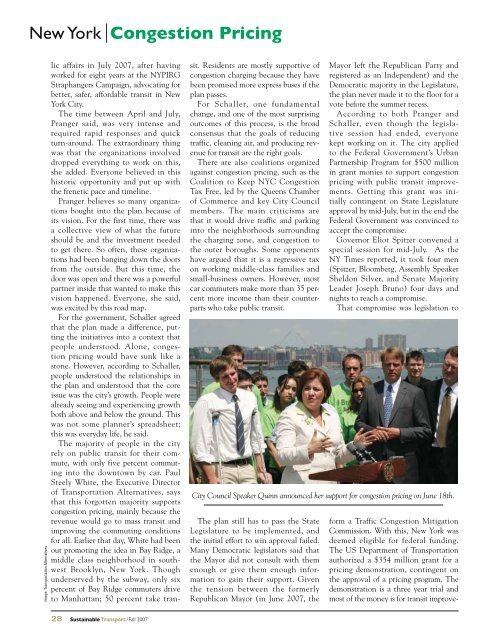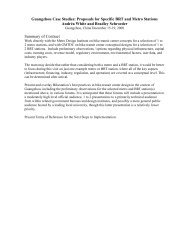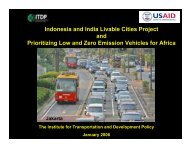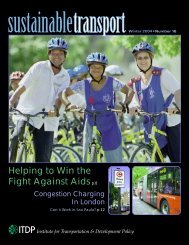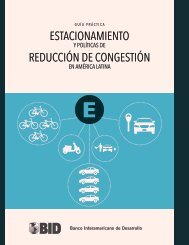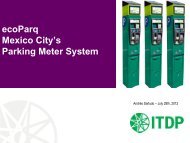Bike Sharing Sweeps Paris Off Its Feet - ITDP | Institute for ...
Bike Sharing Sweeps Paris Off Its Feet - ITDP | Institute for ...
Bike Sharing Sweeps Paris Off Its Feet - ITDP | Institute for ...
You also want an ePaper? Increase the reach of your titles
YUMPU automatically turns print PDFs into web optimized ePapers that Google loves.
New York Congestion Pricing<br />
Image: Transportation Alternatives<br />
lic affairs in July 2007, after having<br />
worked <strong>for</strong> eight years at the NYPIRG<br />
Straphangers Campaign, advocating <strong>for</strong><br />
better, safer, af<strong>for</strong>dable transit in New<br />
York City.<br />
The time between April and July,<br />
Pranger said, was very intense and<br />
required rapid responses and quick<br />
turn-around. The extraordinary thing<br />
was that the organizations involved<br />
dropped everything to work on this,<br />
she added. Everyone believed in this<br />
historic opportunity and put up with<br />
the frenetic pace and timeline.<br />
Pranger believes so many organizations<br />
bought into the plan because of<br />
its vision. For the first time, there was<br />
a collective view of what the future<br />
should be and the investment needed<br />
to get there. So often, these organizations<br />
had been banging down the doors<br />
from the outside. But this time, the<br />
door was open and there was a powerful<br />
partner inside that wanted to make this<br />
vision happened. Everyone, she said,<br />
was excited by this road map.<br />
For the government, Schaller agreed<br />
that the plan made a difference, putting<br />
the initiatives into a context that<br />
people understood. Alone, congestion<br />
pricing would have sunk like a<br />
stone. However, according to Schaller,<br />
people understood the relationships in<br />
the plan and understood that the core<br />
issue was the city’s growth. People were<br />
already seeing and experiencing growth<br />
both above and below the ground. This<br />
was not some planner’s spreadsheet;<br />
this was everyday life, he said.<br />
The majority of people in the city<br />
rely on public transit <strong>for</strong> their commute,<br />
with only five percent commuting<br />
into the downtown by car. Paul<br />
Steely White, the Executive Director<br />
of Transportation Alternatives, says<br />
that this <strong>for</strong>gotten majority supports<br />
congestion pricing, mainly because the<br />
revenue would go to mass transit and<br />
improving the commuting conditions<br />
<strong>for</strong> all. Earlier that day, White had been<br />
out promoting the idea in Bay Ridge, a<br />
middle class neighborhood in southwest<br />
Brooklyn, New York. Though<br />
underserved by the subway, only six<br />
percent of Bay Ridge commuters drive<br />
to Manhattan; 50 percent take transit.<br />
Residents are mostly supportive of<br />
congestion charging because they have<br />
been promised more express buses if the<br />
plan passes.<br />
For Schaller, one fundamental<br />
change, and one of the most surprising<br />
outcomes of this process, is the broad<br />
consensus that the goals of reducing<br />
traffic, cleaning air, and producing revenue<br />
<strong>for</strong> transit are the right goals.<br />
There are also coalitions organized<br />
against congestion pricing, such as the<br />
Coalition to Keep NYC Congestion<br />
Tax Free, led by the Queens Chamber<br />
of Commerce and key City Council<br />
members. The main criticisms are<br />
that it would drive traffic and parking<br />
into the neighborhoods surrounding<br />
the charging zone, and congestion to<br />
the outer boroughs. Some opponents<br />
have argued that it is a regressive tax<br />
on working middle-class families and<br />
small-business owners. However, most<br />
car commuters make more than 35 percent<br />
more income than their counterparts<br />
who take public transit.<br />
The plan still has to pass the State<br />
Legislature to be implemented, and<br />
the initial ef<strong>for</strong>t to win approval failed.<br />
Many Democratic legislators said that<br />
the Mayor did not consult with them<br />
enough or give them enough in<strong>for</strong>mation<br />
to gain their support. Given<br />
the tension between the <strong>for</strong>merly<br />
Republican Mayor (in June 2007, the<br />
Mayor left the Republican Party and<br />
registered as an Independent) and the<br />
Democratic majority in the Legislature,<br />
the plan never made it to the floor <strong>for</strong> a<br />
vote be<strong>for</strong>e the summer recess.<br />
According to both Pranger and<br />
Schaller, even though the legislative<br />
session had ended, everyone<br />
kept working on it. The city applied<br />
to the Federal Government’s Urban<br />
Partnership Program <strong>for</strong> $500 million<br />
in grant monies to support congestion<br />
pricing with public transit improvements.<br />
Getting this grant was initially<br />
contingent on State Legislature<br />
approval by mid-July, but in the end the<br />
Federal Government was convinced to<br />
accept the compromise.<br />
Governor Eliot Spitzer convened a<br />
special session <strong>for</strong> mid-July. As the<br />
NY Times reported, it took four men<br />
(Spitzer, Bloomberg, Assembly Speaker<br />
Sheldon Silver, and Senate Majority<br />
Leader Joseph Bruno) four days and<br />
nights to reach a compromise.<br />
That compromise was legislation to<br />
City Council Speaker Quinn announced her support <strong>for</strong> congestion pricing on June 18th.<br />
<strong>for</strong>m a Traffic Congestion Mitigation<br />
Commission. With this, New York was<br />
deemed eligible <strong>for</strong> federal funding.<br />
The US Department of Transportation<br />
authorized a $354 million grant <strong>for</strong> a<br />
pricing demonstration, contingent on<br />
the approval of a pricing program. The<br />
demonstration is a three year trial and<br />
most of the money is <strong>for</strong> transit improve-<br />
28 Sustainable Transport /Fall 2007


